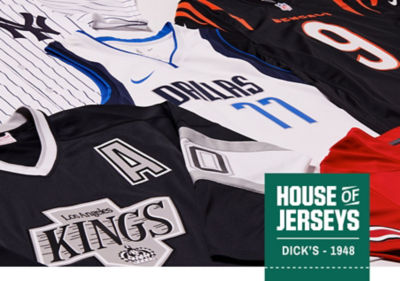The Basics of Fantasy Football
Learn what you need to know before capturing your league’s trophy with these fantasy football tips.

Some friends or coworkers have asked you to join their fantasy football league. You agreed and can’t wait to get started. But there’s just one problem.
You don’t know where to start.
Don’t fret. Pro Tips is here with a breakdown of all the basics of fantasy football and fantasy football scoring. From the draft to the championship game, we’ll get you up to speed for the season with these fantasy football tips.
WHAT IS FANTASY FOOTBALL?
In fantasy football, you act as the general manager of your team. You draft a team of real-life players and face off against other teams in the league each week. Leagues can include professional or college players.
How the players in your starting lineup do on the field decides your score. Quarterback throws a touchdown? You get points. Running back fumbles the ball? You lose points.
TYPES OF FANTASY FOOTBALL LEAGUES
There are a wide variety of fantasy league formats to experience. Here are some of the leagues you’ll commonly encounter:
- Head-to-Head Leagues: This is the most common format. You’ll face off with an opponent, and the winner is the team with the most points at the conclusion of that week’s games. Teams with the best record will advance to the playoffs at the end of the season.
- Total Point Leagues: Teams accumulate points on an ongoing basis. Each team’s total points determine the standings.
- All Play League: Every team plays each other from week to week. In a 10-team league, the highest scoring team would be 9-0, the second highest would be 8-1, etc.
THE FANTASY FOOTBALL DRAFT
Your league will kick off with a draft. You and your fellow competitors will take turns drafting players to fill out your rosters. There are two types of drafts:
- Snake Draft: Members of the league take turns drafting players from first to last. However, the order is then reversed in the following round. For example: Player A will draft first in the odd rounds. But they will draft last in the even rounds.
- Auction Draft: Players have a set budget. They need to bid on players to fill their roster. The highest bidder for a certain player will get that player on their team.
Some drafts will use a combination of these two methods. League members bid for a certain number of players then go through a snake draft to fill the rest of their roster. Meanwhile, dynasty leagues allow players to keep their roster from season to season. The draft only features rookie players.
Most leagues use a live draft. This requires you to use real-time strategy to complete your roster. However, some leagues may use an auto draft. Members will rank players ahead of time, and the draft is then automated. If a member of your league is not available for a live draft, they can often rank players beforehand for an automated draft.
Some leagues will have the members do a live draft in person and make it a party. You can add some pageantry with a big draft board.
HOW TO BUILD A FANTASY FOOTBALL TEAM ROSTER
Before the draft, make sure you understand your league’s roster rules. You have a limited amount of space to fill each starting spot from week to week.
Many leagues use this standard lineup format:
- Quarterback
- Running Backs (2)
- Wide Receivers (2)
- Flex (either a running back, wide receiver or tight end)
- Tight End
- Kicker
- Team Defense/Special Teams
- Bench (this can vary by league; these players will not score any points)
But there can be variations to this.
- Some leagues will use individual defensive players (IDPs) and punters instead of a team defense/special teams.
- You can also adjust the offensive starters. Some leagues require you to start two quarterbacks. Others will have additional flex spots.
- Flex is typically limited to a running back, wide receiver or tight end. However, super flex leagues allow you to fill the flex spot with any offensive player, like a quarterback.
Throughout the season, you may be able to pick up free agents who were not drafted. Also, you may be able to trade players to another team in the league. These options can be helpful if you have an injured player.
Some leagues will allow you to put an injured player on injured reserve. This allows you to keep a player on your roster, but not have it count against your roster numbers.
Bonus Pro Tip: Be aware of which weeks your players have a bye. You don’t want to go into a week without a starting quarterback or with only one wide receiver.
FANTASY FOOTBALL SCORING
Your points come from your starting lineup. The statistics your players accumulate during their games translate into your league’s scoring system.
Scoring systems can vary from league to league. A standard scoring system is as follows:
- 1 point for 25 passing yards
- 1 point for 10 rushing yards
- 1 point for 10 receiving yards
- 6 points for a receiving or rushing touchdown
- 4 points for a passing touchdown
- -2 points for every interception thrown or fumble lost
- 1 point for each extra point made
- 2 points for rushing or receiving 2-point conversion
- 2 points for passing 2-point conversion
- 3 points for each 0-39 yard field goal
- 4 points for each 40-49 yard field goal
- 5 points for each 50+ yard field goal
- 2 points per turnover gained by the defense
- 1 point per sack by the defense
- 2 points for a safety by the defense
- 6 points for each touchdown scored by the defense
- 2 points for each blocked kick
If your league is using team defense/special teams, you can gain or lose points for how many points the defense allows. An example of this variation is:
- No Points Allowed: 10 points
- 1-6 Points Allowed: 7 points
- 7-13 Points Allowed: 4 points
- 14-20 Points Allowed: 1 point
- 21-27 Points Allowed: 0 points
- 28-34 Points Allowed: -1 point
- 35+ Points Allowed: -4 points
There are a variety of fantasy scoring systems. Some variations you may encounter:
- Points Per Reception: This is an enhancement of the standard scoring system. Each reception by an offensive player is worth a point. This style of play is known as PPR leagues.
- Individual Defensive Player: If you are in an IDP league, you’ll gain a variety of points from the performance of your defensive players.
- Tackles, pass deflections and quarterback hits are worth 1 point.
- Assisted tackles are worth a half point.
- Fumbles forced, fumbles recovered and interceptions are worth 3 points.
- Defensive touchdowns are worth 6 points.
Fantasy leagues can help add another level of excitement to the real games. Now that you know the basics of fantasy football, you’ll be ready to lead your team to the championship game.








